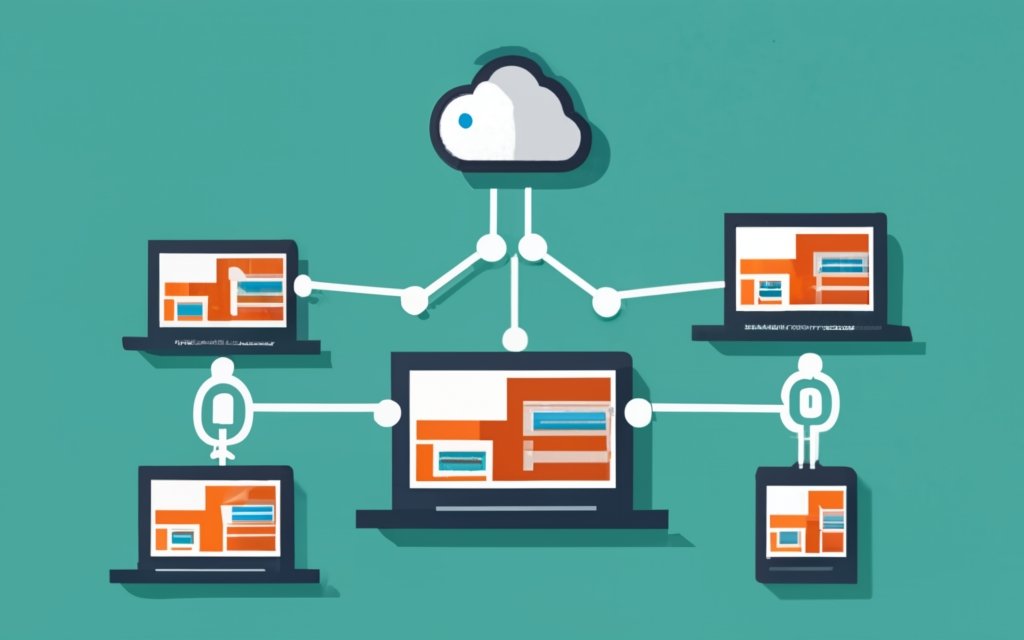
Understanding Azure networking is crucial for passing the AZ104 Microsoft Azure Administrator certification exam and managing real-world Azure environments. Let’s explore why…
The AZ104 exam tests critical skills for administering Azure infrastructure, with networking knowledge being essential. This article will demonstrate how virtual networks, security groups, load balancing, and other key networking topics tie into the exam and everyday Azure administration roles.
Whether you’re prepping for AZ104 or just want to level up your Azure skills, learning these core networking concepts in-depth will make you a more effective cloud operator. So let’s dig in!
Introduction: An Overview of the AZ104 Exam and Azure Networking
The AZ104 Microsoft Azure Administrator certification confirms your ability to manage Azure subscriptions, secure identities, implement solutions, and monitor infrastructure.
Azure networking is a major part of the exam, covered in skills like:
- Configuring virtual networks and connections
- Controlling access with security groups
- Routing traffic with load balancers
- Monitoring VPNs and gateways
In fact, the exam dedicates 15-20% of its content just to networking tasks.
Why this strong emphasis? Because understanding core Azure network concepts allows administrators to:
- Securely interconnect resources
- Safely expose services
- Route data effectively
- Grant fine-grained access
- Monitor all infrastructure
In other words, mastering Azure virtual networks and related services is mandatory for anyone managing real-world cloud deployments.
So for those aiming to pass AZ104 and gain these practical skills, this article will be an invaluable resource!
Key Azure Networking Concepts
Now let’s explore some fundamental Azure networking pillars that are critical to understand.
Virtual Networks
Virtual networks (VNets) act as an isolated private network in the Azure cloud. Key features include:
- Segmentation – Divide a VNet into multiple subnets to control access
- Addressing – Assign private RFC1918 IP addresses to resources
- Routing – Direct data flows across subnets, VNets, on-prem networks
- Security – Lock down access to VNets and subnets with NSGs
- Services – Host Azure IaaS and PaaS services within VNets
Some usage examples include:
- Place Azure VMs on isolated, secured subnets
- Extend on-prem networks via site-to-site VPNs
- Enable PaaS services to access private data securely
So in summary, VNet is the foundation for any Azure network.
Creating and Configuring VNets and Subnets
When building out an Azure virtual network, key steps involve:
- Creating a VNet with a private RFC1918 address space
- Segmenting the VNet into subnets
- Associating NSG rules to secure subnets
- Creating route tables to define data flows
- Linking the VNet to other networks as needed
Following Azure best practices here allows you to establish granular access controls and flexible routing schemes.
Public IP Addresses
IP addresses allow Azure resources to be reached from the Internet:
- Dynamic – Address changes on resource deallocation
- Static – Persistent address sticks to resource
Public IPs should be used sparingly to restrict exposure. Resources like VPN gateways and load balancers often utilize static IPs.
Virtual Network Peering
Virtual network peering directly connects two VNets in Azure:
- Simple to set up
- Non-transitive relationships
- Cross-region peering available
- No single point of failure
Peering helps share services across VNets without complex VPNs.
Configuring VNet Peering
Steps to connect two Azure VNets with peering include:
- Ensuring non-overlapping RFC1918 address spaces
- Creating peering relationships between VNets
- Configuring access controls and traffic forwarding
- Testing connectivity between peered VNets
Proper planning upfront simplifies peering configuration.
User-Defined Routes
Azure routes network traffic based on a default table. User-defined routes override this with custom rules like:
- Forcing tunneling via network virtual appliances
- Forwarding subnets across VNet peerings
- Directing Internet traffic via proxy VMs
- Routing subnets to isolated network containers
This grants administrators more granular control over how traffic flows through Azure networks.
Network Security and Access Controls
Now let’s explore key Azure services for locking down VNets.
Network Security Groups
Network security groups (NSGs) are firewall rules enforced at the network level. Key capabilities include:
- Access grants and denials based on 5-tuple rules
- Ability to assign NSGs at subnet and NIC levels
- Defaults to denying all inbound, allowing outbound
- Layer 3+4 only (no L7 inspection features)
- Distributed across hosts, not bottlenecked
With NSGs, you can build granular whitelist firewall policies into your Azure networks.
Creating and Configuring NSGs
Typical steps for implementing NSGs involve:
- Creating an NSG container
- Adding ACL rules to allow/deny traffic
- Associating NSGs to subnet(s) and NICs
- Prioritizing rules with precedence
- Logging and monitoring traffic flows
You can apply NSGs across multiple subnets and resources. But poor planning can lead to connectivity issues.
Application Security Groups
Application security groups (ASGs) are logical groupings of Azure resources, useful for security rules. Advantages include:
- Creating logical “apps” spanning services + networks
- Simplifying complex policy assignments
- Abstracting backend changes from access controls
- Avoiding repetitive individual rules
Grouping resources into ASGs cuts down on redundant policy assignments.
Configuring Application Security Groups
Steps for implementing ASGs include:
- Creating application security group containers
- Adding Azure resources like VMs, subnets, etc. into groups
- Referencing ASGs in place of IP addresses when assigning access policies
- Combining ASGs and service tags in rules for abstraction
Maintenance becomes easier since you update group membership rather than individual rules.
Azure Bastion
Azure Bastion provides secure RDP/SSH connectivity to VNet resources without exposing ports publicly:
- Accessed through Azure portal and CLI
- SSL-wrapped RDP/SSH sessions
- No public IPs required on target VMs
- Locked down completely to VNet traffic
Bastion allows private access to internal resources without VPNs or public exposure.
Implementing Azure Bastion
Typical Bastion deployment steps include:
- Creating Azure Bastion resource in target VNet
- Assigning Bastion subnet with special considerations
- Setting NSG rules to restrict Bastion subnet access
- Connecting to private VNet resources via SSL gateway
With few attack surfaces and secure protocols, Azure Bastion is a administrator’s dream!
Name Resolution and Load Balancing
Now let’s explore key Azure services for enabling DNS and distributing loads.
Azure DNS
The Azure DNS service provides hostname resolution with benefits like:
- Self-service DNS domain hosting
- Override default Azure-provided name resolution
- Integrates with on-prem DNS servers
- Alias records to absorb changes
- Failover across Azure regions
Control your own DNS zones for stability, security, and flexibility.
Configuring Azure DNS
Steps for setting up Azure DNS include:
- Creating a DNS zone (public or private)
- Importing existing DNS records
- Registering VM hostnames in the zone
- Adding policies for DNS record lifecycle
- Testing name resolution from clients
With Azure DNS, you don’t have to rely on transient default naming.
Load Balancing
Load balancers evenly distribute inbound and outbound connections across backend pool instances. Key capabilities include:
- Public IP-based Internet load balancing
- Internal distribution of traffic inside VNets
- Health probes and auto-scaling
- SSL offloading support
- Zone redundant standard SKU
Balancers allow applications to achieve high availability and performance.
Configuring Load Balancing
Typical load balancer deployment steps involve:
- Attaching public or private front end IP
- Adding backends via VM NICs or IP addresses
- Configuring health probe and distribution rules
- Opening firewalls to health/backend access points
- Testing traffic distribution to backends
With smart probes and traffic policies, Azure balances can handle demanding workloads.
Securing Access to Virtual Networks
We’ll now explore advanced techniques for locking down VNet access even further.
Service Endpoints
Azure service endpoints secure PaaS data by restricting connectivity to single VNets. Benefits include:
- Locking PaaS service access down to one VNet
- Replacing firewall rules with simple VNet ACLs
- Preventing data exfiltration via intermediate hops
- Easy to set up with minimum maintenance
Service endpoints help fortify PaaS access controls.
Configuring Service Endpoints
The steps to set up service endpoints are:
- Enabling endpoint on VNet subnet
- Selecting target PaaS services to allow
- Adding VNet subnet to allowed list
- Testing access to services from endpoint
Just allowing one trusted VNet radically reduces exposure.
Private Endpoints
Private endpoints assign private IP addresses to connect PaaS services through VNets. Advantages include:
- Direct private connectivity from VNets
- No data exposure on public networks
- Granular access control via VNet NSGs
- Reduced costs from VPNs and peering
Private endpoints are a secure way to directly access PaaS through VNets.
Configuring Private Endpoints
Steps to set up private endpoints involve:
- Creating endpoint and associating PaaS resource
- Assigning subnet and private IP allocation
- Configuring DNS records for resolution
- Locking down endpoint subnet with NSG
With easy DNS registration and NSG support, private endpoints neatly secure PaaS access.
Monitoring and Troubleshooting Network Connectivity
Let’s now discuss how to monitor Azure virtual networks and troubleshoot issues.
Monitoring Tools and Techniques
It’s critical to actively monitor network health in Azure. Tactics include:
- Azure Network Watcher – Diagnostic tool for checking connectivity and catching unwanted traffic
- Flow logs – Capture IP flow details for traffic analysis
- Azure Monitor logs – Ship flow/NSG data to Log Analytics for dashboards/alerting
- Third-party tools – Alternatives like SolarWinds, PRTG, etc.
Continuously collecting analytics allows rapid detection of anomalies.
Troubleshooting Common Network Issues
When connectivity or performance problems arise, common culprits include:
- Incorrect routing configuration forcing improper pathing
- Overly restrictive NSG rules blocking access unexpectedly
- DNS registration issues preventing name resolution
- VPN tunnels failing and disabling hybrid connectivity
- DDoS attacks overloading infrastructure capacity
Having visibility through logs and watcher enables rapid troubleshooting.
Best Practices and Recommendations
Here are some top tips for effectively implementing Azure networks:
Virtual Networks
- Plan IP addressing and subnets carefully from the start
- Align to organizational department/app segmentation strategy
- Enable service endpoints and private links for PaaS security
Network Security Groups
- Apply NSGs to subnets first, then selectively to NICs
- Log all traffic flows and analyze regularly
- Assign descriptive names and grouping tags
Connectivity
- Use peering over VPNs when possible
- Introduce network virtual appliances where needed
- Follow Azure Well-Architected Framework networking pillars
Adhering to recommendations prevents many outages and firefights down the road!
Conclusion: Azure Networking is Critical for AZ104 and Managing Cloud Environments
This article explored why Azure networking is indispensable for passing the AZ104 exam and overseeing real-world cloud deployments.
We covered fundamental concepts like VNets, NSGs, and load balancing that enable administrators to securely interconnect resources across the Azure fabric.
You also learned actionable techniques for monitoring and troubleshooting networks when issues arise.
Following this guidance will give you tremendous confidence for acing the networking aspects of the AZ104 certification test.
Even more importantly, mastering these Azure virtual network best practices will make you an empowered infrastructure operator beyond the exam as well!
So start hands-on learning today, and let your cloud networking career flourish!








